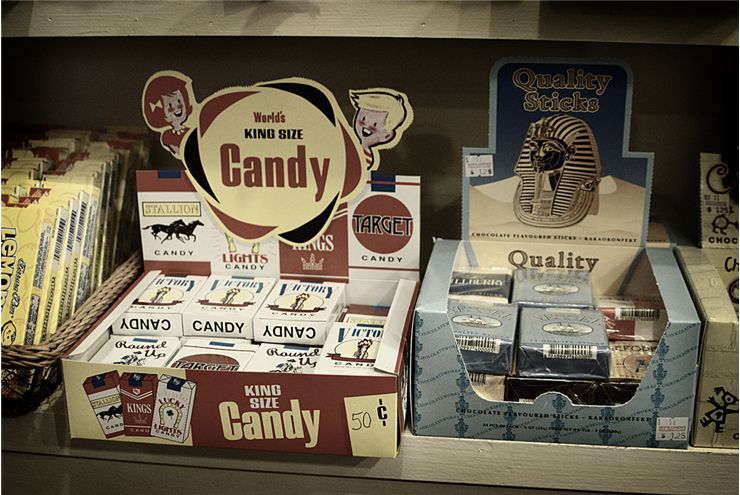Bubble Gum Cigars and Cigarettes
Ever since chewing gums entered the market in the 2nd part of the 19th century, manufacturers and promoters constantly tried to expand their audience and reach customers in new-age groups. One of the most successful products that targeted kids in the early 1900s was bubble gum cigars, chewing gum products that were intentionally created to emulate the look of cigarettes. These popular sweets, designed to be very sugary and attractive to kids, started being made in chewing gum from chocolate, chalky sugar, and several other confectionery materials and aromas. The packaging looked like ordinary cigars but with clear signs that this product was candy. When opened, individual sticks of gum have hidden a roll of paper below, allowing the child to play with the “fake cigarettes” a bit before removing the paper and enjoying the product.
While bubble gum cigars almost always stuck to this basic design, other forms of candy cigarettes tried to offer additional features, such as a thin layer of powdered sugar that was placed between the candy and wrapper. This hole enabled children to blow air through a cigar, producing fake smoke on the far end of the stick. Some bubble gum cigars (and, in general, other candy cigarettes) can sometimes be found with red color tips. This coloring was there to look like the fake cigarettes were lit.
Since this type of sweet confectionery promotes harmful health items to kids, opponents of bubble gum cigarettes were numerous from the moment they started becoming popular worldwide. The pressure from the public and several commissioned examinations of their impact on kids (none with conclusive results) caused bubble gum cigarettes to become much more regulated than other candy products. In many countries, modern gum cigars have specific markings and warning signs on their packaging. Their promotion is limited, and the final design of the edible product has to fit with the rules (or standard practices). For example, bubble gum cigarettes with red-colored tips are rare because manufacturers do not want to emulate cigar designs so much for fear of causing a public reaction from parents.
Parent reactions shaped much of the history of bubble gum cigarettes. Pressures from the public that lasted almost throughout the 2nd half of the 20th century caused weaker sales and fewer new designs. In contrast, several countries severely limited the promotion and sales or completely blocked them. For example, candy cigarettes are banned in countries such as Brazil, Norway, Finland, Ireland, Turkey, Saudi Arabia, and the entire city of Singapore (except when prescribed by doctors). In contrast, partial bans exist in Canada (where candy cigars cannot resemble tobacco cigar brands) and New Zealand.
Even now, candy cigars of all types are getting a constant negative reputation from the public. Parents do not want their kids to get attached to the candies that promote items or substances dangerous to health.
